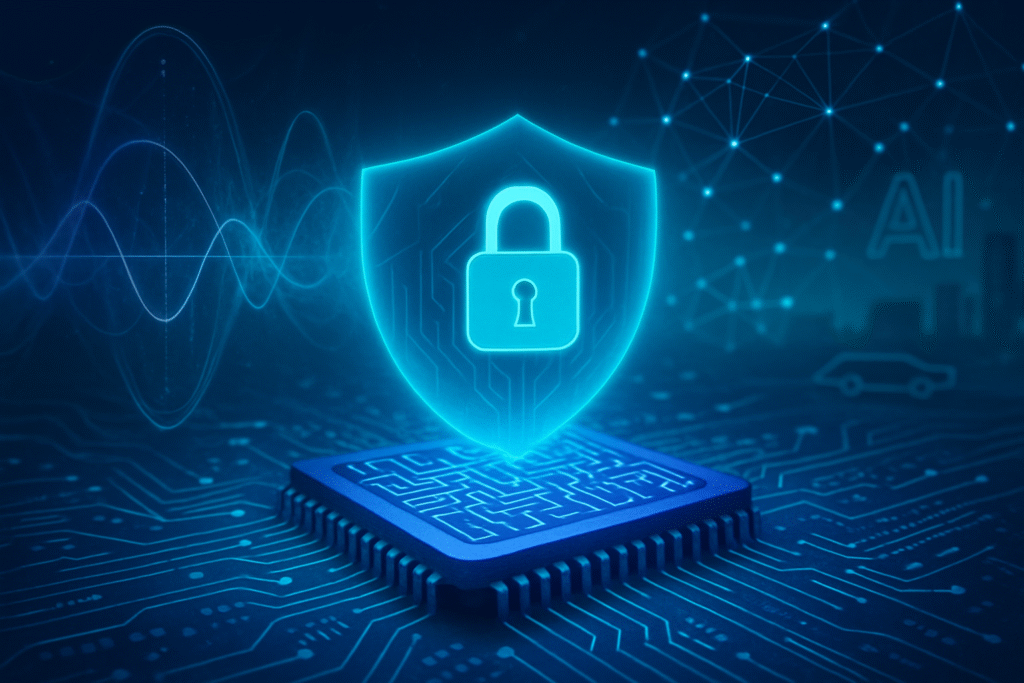
San Jose, CA – October 14, 2025 – In a landmark move poised to redefine the landscape of secure computing and AI applications, Lattice Semiconductor (NASDAQ: LSCC) yesterday announced the launch of its groundbreaking Post-Quantum Secure FPGAs. The new Lattice MachXO5 -NX TDQ family represents the industry's first secure control FPGAs to offer full Commercial National Security Algorithm (CNSA) 2.0-compliant post-quantum cryptography (PQC) support. This pivotal development arrives as the world braces for the imminent threat of quantum computers capable of breaking current encryption standards, establishing a critical hardware foundation for future-proof AI systems and digital infrastructure.
-NX TDQ family represents the industry's first secure control FPGAs to offer full Commercial National Security Algorithm (CNSA) 2.0-compliant post-quantum cryptography (PQC) support. This pivotal development arrives as the world braces for the imminent threat of quantum computers capable of breaking current encryption standards, establishing a critical hardware foundation for future-proof AI systems and digital infrastructure.
The immediate significance of these FPGAs cannot be overstated. With the specter of "harvest now, decrypt later" attacks looming, where encrypted data is collected today to be compromised by future quantum machines, Lattice's solution provides a tangible and robust defense. By integrating quantum-resistant security directly into the hardware root of trust, these FPGAs are set to become indispensable for securing sensitive AI workloads, particularly at the burgeoning edge of the network, where power efficiency, low latency, and unwavering security are paramount. This launch positions Lattice at the forefront of the race to secure the digital future against quantum adversaries, ensuring the integrity and trustworthiness of AI's expanding reach.
Technical Fortifications: Inside Lattice's Quantum-Resistant FPGAs
The Lattice MachXO5 -NX TDQ family, built upon the acclaimed Lattice Nexus
-NX TDQ family, built upon the acclaimed Lattice Nexus platform, brings an unprecedented level of security to control FPGAs. These devices are meticulously engineered using low-power 28 nm FD-SOI technology, boasting significantly improved power efficiency and reliability, including a 100x lower soft error rate (SER) compared to similar FPGAs, crucial for demanding environments. Devices in this family range from 15K to 100K logic cells, integrating up to 7.3Mb of embedded memory and up to 55Mb of dedicated user flash memory, enabling single-chip solutions with instant-on operation and reliable in-field updates.
platform, brings an unprecedented level of security to control FPGAs. These devices are meticulously engineered using low-power 28 nm FD-SOI technology, boasting significantly improved power efficiency and reliability, including a 100x lower soft error rate (SER) compared to similar FPGAs, crucial for demanding environments. Devices in this family range from 15K to 100K logic cells, integrating up to 7.3Mb of embedded memory and up to 55Mb of dedicated user flash memory, enabling single-chip solutions with instant-on operation and reliable in-field updates.
At the heart of their innovation is comprehensive PQC support. The MachXO5-NX TDQ FPGAs are the first secure control FPGAs to offer full CNSA 2.0-compliant PQC, integrating a complete suite of NIST-approved algorithms. This includes the Lattice-based Module-Lattice-based Digital Signature Algorithm (ML-DSA) and Key Encapsulation Mechanism (ML-KEM), alongside the hash-based LMS (Leighton-Micali Signature Scheme) and XMSS (eXtended Merkle Signature Scheme). Beyond PQC, they also maintain robust classical cryptographic support with AES-CBC/GCM 256-bit, ECDSA-384/521, SHA-384/512, and RSA 3072/4096-bit, ensuring a multi-layered defense. A robust Hardware Root of Trust (HRoT) provides a trusted single-chip boot, a unique device secret (UDS), and secure bitstream management with revokable root keys, aligning with standards like DICE and SPDM for supply chain security.
A standout feature is the patent-pending "crypto-agility," which allows for in-field algorithm updates and anti-rollback version protection. This capability is a game-changer in the evolving PQC landscape, where new algorithms or vulnerabilities may emerge. Unlike fixed-function ASICs that would require costly hardware redesigns, these FPGAs can be reprogrammed to adapt, ensuring long-term security without hardware replacement. This flexibility, combined with their low power consumption and high reliability, significantly differentiates them from previous FPGA generations and many existing security solutions that lack integrated, comprehensive, and adaptable quantum-resistant capabilities.
Initial reactions from the industry and financial community have been largely positive. Experts, including Lattice's Chief Strategy and Marketing Officer, Esam Elashmawi, underscore the urgent need for quantum-resistant security. The MachXO5-NX TDQ is seen as a crucial step in future-proofing digital infrastructure. Lattice's "first to market" advantage in secure control FPGAs with CNSA 2.0 compliance has been noted, with the company showcasing live demonstrations at the OCP Global Summit, targeting AI-optimized datacenter infrastructure. The positive market response, including a jump in Lattice Semiconductor's stock and increased analyst price targets, reflects confidence in the company's strategic positioning in low-power FPGAs and its growing relevance in AI and server markets.
Reshaping the AI Competitive Landscape
Lattice's Post-Quantum Secure FPGAs are poised to significantly impact AI companies, tech giants, and startups by offering a crucial layer of future-proof security. Companies heavily invested in Edge AI and IoT devices stand to benefit immensely. These include developers of smart cameras, industrial robots, autonomous vehicles, 5G small cells, and other intelligent, connected devices where power efficiency, real-time processing, and robust security are non-negotiable. Industrial automation, critical infrastructure, and automotive electronics sectors, which rely on secure and reliable control systems for AI-driven applications, will also find these FPGAs indispensable. Furthermore, cybersecurity providers and AI labs focused on developing quantum-safe AI environments will leverage these FPGAs as a foundational platform.
The competitive implications for major AI labs and tech companies are substantial. Lattice gains a significant first-mover advantage in delivering CNSA 2.0-compliant PQC hardware. This puts pressure on competitors like AMD's Xilinx and Intel's Altera to accelerate their own PQC integrations to avoid falling behind, particularly in regulated industries. While tech giants like IBM, Google, and Microsoft are active in PQC, their focus often leans towards software, cloud platforms, or general-purpose hardware. Lattice's hardware-level PQC solution, especially at the edge, complements these efforts and could lead to new partnerships or increased adoption of FPGAs in their secure AI architectures. For example, Lattice's existing collaboration with NVIDIA for edge AI solutions utilizing the Orin platform could see enhanced security integration.
This development could disrupt existing products and services by accelerating the migration to PQC. Non-PQC-ready hardware solutions risk becoming obsolete or high-risk in sensitive applications due to the "harvest now, decrypt later" threat. The inherent crypto-agility of these FPGAs also challenges fixed-function ASICs, which would require costly redesigns if PQC algorithms are compromised or new standards emerge, making FPGAs a more attractive option for core security functions. Moreover, the FPGAs' ability to enhance data provenance with quantum-resistant cryptographic binding will disrupt existing data integrity solutions lacking such capabilities, fostering greater trust in AI systems. The complexity of PQC migration will also spur new service offerings, creating opportunities for integrators and cybersecurity firms.
Strategically, Lattice strengthens its leadership in secure edge AI, differentiating itself in a market segment where power, size, and security are paramount. By offering CNSA 2.0-compliant PQC and crypto-agility, Lattice provides a solution that future-proofs customers' infrastructure against evolving quantum threats, aligning with mandates from NIST and NSA. This reduces design risk and accelerates time-to-market for developers of secure AI applications, particularly through solution stacks like Lattice Sentry (for cybersecurity) and Lattice sensAI (for AI/ML). With the global PQC market projected to grow significantly, Lattice's early entry with a hardware-level PQC solution positions it to capture a substantial share, especially within the rapidly expanding AI hardware sector and critical compliance-driven industries.
A New Pillar in the AI Landscape
Lattice Semiconductor's Post-Quantum Secure FPGAs represent a pivotal, though evolutionary, step in the broader AI landscape, primarily by establishing a foundational layer of security against the existential threat of quantum computing. These FPGAs are perfectly aligned with the prevailing trend of Edge AI and embedded intelligence, where AI workloads are increasingly processed closer to the data source rather than in centralized clouds. Their low power consumption, small form factor, and low latency make them ideal for ubiquitous AI deployments in smart cameras, industrial robots, autonomous vehicles, and 5G infrastructure, enabling real-time inference and sensor fusion in environments where traditional high-power processors are impractical.
The wider impact of this development is profound. It provides a tangible means to "future-proof" AI models, data, and communication channels against quantum attacks, safeguarding critical infrastructure across industrial control, defense, and automotive sectors. This democratizes secure edge AI, making advanced intelligence trustworthy and accessible in a wider array of constrained environments. The integrated Hardware Root of Trust and crypto-agility features also enhance system resilience, allowing AI systems to adapt to evolving threats and maintain integrity over long operational lifecycles. This proactive measure is critical against the predicted "Y2Q" moment, where quantum computers could compromise current encryption within the next decade.
However, potential concerns exist. The inherent complexity of designing and programming FPGAs can be a barrier compared to the more mature software ecosystems of GPUs for AI. While FPGAs excel at inference and specialized tasks, GPUs often retain an advantage for large-scale AI model training due to higher gate density and optimized architectures. The performance and resource constraints of PQC algorithms—larger key sizes and higher computational demands—can also strain edge devices, necessitating careful optimization. Furthermore, the evolving nature of PQC standards and the need for robust crypto-agility implementations present ongoing challenges in ensuring seamless updates and interoperability.
In the grand tapestry of AI history, Lattice's PQC FPGAs do not represent a breakthrough in raw computational power or algorithmic innovation akin to the advent of deep learning with GPUs. Instead, their significance lies in providing the secure and sustainable hardware foundation necessary for these advanced AI capabilities to be deployed safely and reliably. They are a critical milestone in establishing a secure digital infrastructure for the quantum era, comparable to other foundational shifts in cybersecurity. While GPU acceleration enabled the development and training of complex AI models, Lattice PQC FPGAs are pivotal for the secure, adaptable, and efficient deployment of AI, particularly for inference at the edge, ensuring the trustworthiness and long-term viability of AI's practical applications.
The Horizon of Secure AI: What Comes Next
The introduction of Post-Quantum Secure FPGAs by Lattice Semiconductor heralds a new era for AI, with significant near-term and long-term developments on the horizon. In the near term, the immediate focus will be on the accelerated deployment of these PQC-compliant FPGAs to provide urgent protection against both classical and nascent quantum threats. We can expect to see rapid integration into critical infrastructure, secure AI-optimized data centers, and a broader range of edge AI devices, driven by regulatory mandates like CNSA 2.0. The "crypto-agility" feature will be heavily utilized, allowing early adopters to deploy systems today with the confidence that they can adapt to future PQC algorithm refinements or new vulnerabilities without costly hardware overhauls.
Looking further ahead, the long-term impact points towards the ubiquitous deployment of truly autonomous and pervasive AI systems, secured by increasingly power-efficient and logic-dense PQC FPGAs. These devices will evolve into highly specialized AI accelerators for tasks in robotics, drone navigation, and advanced medical devices, offering unparalleled performance and power advantages. Experts predict that by the late 2020s, hardware accelerators for lattice-based mathematics, coupled with algorithmic optimizations, will make PQC feel as seamless as current classical cryptography, even on mobile devices. The vision of self-sustaining edge AI nodes, potentially powered by energy harvesting and secured by PQC FPGAs, could extend AI capabilities to remote and off-grid environments.
Potential applications and use cases are vast and varied. Beyond securing general AI infrastructure and data centers, PQC FPGAs will be crucial for enhancing data provenance in AI systems, protecting against data poisoning and malicious training by cryptographically binding data during processing. In industrial and automotive sectors, they will future-proof critical systems like ADAS and factory automation. Medical and life sciences will leverage them for securing diagnostic equipment, surgical robotics, and genome sequencing. In communications, they will fortify 5G infrastructure and secure computing platforms. Furthermore, AI itself might be used to optimize PQC protocols in real-time, dynamically managing cryptographic agility based on threat intelligence.
However, significant challenges remain. PQC algorithms typically demand more computational resources and memory, which can strain power-constrained edge devices. The complexity of designing and integrating FPGA-based AI systems, coupled with a still-evolving PQC standardization landscape, requires continued development of user-friendly tools and frameworks. Experts predict that quantum computers capable of breaking RSA-2048 encryption could arrive as early as 2030-2035, underscoring the urgency for PQC operationalization by 2025. This timeline, combined with the potential for hybrid quantum-classical AI threats, necessitates continuous research and proactive security measures. FPGAs, with their flexibility and acceleration capabilities, are predicted to drive a significant portion of new efforts to integrate AI-powered features into a wider range of applications.
Securing AI's Quantum Future: A Concluding Outlook
Lattice Semiconductor's launch of Post-Quantum Secure FPGAs marks a defining moment in the journey to secure the future of artificial intelligence. The MachXO5 -NX TDQ family's comprehensive PQC support, coupled with its unique crypto-agility and robust Hardware Root of Trust, provides a critical defense mechanism against the rapidly approaching quantum computing threat. This development is not merely an incremental upgrade but a foundational shift, enabling the secure and trustworthy deployment of AI, particularly at the network's edge.
-NX TDQ family's comprehensive PQC support, coupled with its unique crypto-agility and robust Hardware Root of Trust, provides a critical defense mechanism against the rapidly approaching quantum computing threat. This development is not merely an incremental upgrade but a foundational shift, enabling the secure and trustworthy deployment of AI, particularly at the network's edge.
The significance of this development in AI history cannot be overstated. While past AI milestones focused on computational power and algorithmic breakthroughs, Lattice's contribution addresses the fundamental issue of trust and resilience in an increasingly complex and threatened digital landscape. It provides the essential hardware layer for AI systems to operate securely, ensuring their integrity from the ground up and future-proofing them against unforeseen cryptographic challenges. The ability to update cryptographic algorithms in the field is a testament to Lattice's foresight, guaranteeing that today's deployments can adapt to tomorrow's threats.
In the long term, these FPGAs are poised to be indispensable components in the proliferation of autonomous systems and pervasive AI, driving innovation across critical sectors. They lay the groundwork for an era where AI can be deployed with confidence in high-stakes environments, knowing that its underlying security mechanisms are quantum-resistant. This commitment to security and adaptability solidifies Lattice's position as a key enabler for the next generation of intelligent, secure, and resilient AI applications.
As we move forward, several key areas warrant close attention in the coming weeks and months. The ongoing demonstrations at the OCP Global Summit will offer deeper insights into practical applications and early customer adoption. Observers should also watch for the expansion of Lattice's solution stacks, which are crucial for accelerating customer design cycles, and monitor the company's continued market penetration, particularly in the rapidly evolving automotive and industrial IoT sectors. Finally, any announcements regarding new customer wins, strategic partnerships, and how Lattice's offerings continue to align with and influence global PQC standards and regulations will be critical indicators of this technology's far-reaching impact.
This content is intended for informational purposes only and represents analysis of current AI developments.
TokenRing AI delivers enterprise-grade solutions for multi-agent AI workflow orchestration, AI-powered development tools, and seamless remote collaboration platforms.
For more information, visit https://www.tokenring.ai/.


















